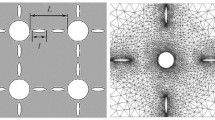Abstract
The paper proposes a mechanical simulation model based on continuum damage mechanics and physical mesomechanics to describe the accumulation of dispersed damages in polycrystalline materials, considering that the main damaging factors are dispersed microcracks and internal stresses produced primarily by linear structural defects. From the proposed model follows a statistical limit state criterion consistent with failure conditions for brittle and ductile structural materials. The limit state criterion is applied to several typical cases of failure and elastic-to-elastoplastic strain transition in polycrystalline structural materials. Based on the model, an acoustic approach to damage assessments of structural materials is also proposed. With the approach, several acoustic effects are identified from the propagation of elastic pulses in a damaged material. Such effects can be useful for instrumental damage assessment of materials (specimens, structural elements) at any time of loading or operation. The acoustic approach can provide a basis for a method of measuring the damage parameters included in the model. The experimental data available to us suggest that the proposed approach to damage assessment is correct for structural materials and is promising for further experimental research to develop instrumental express methods of monitoring dispersed damages in metal structures exposed to thermomechanical loads.



Similar content being viewed by others
REFERENCES
Volkov, I.A. and Korotkikh, Yu.G., Equations of State of Damaged Viscoelastoplastic Media, Moscow: Fizmatlit, 2008.
Volkov, I.A., Korotkikh, Yu.G., and Tarasov, I.S., Numerical Modeling of Damage Accumulation Under Complex Plastic Deformation, Comput. Contin. Mech., 2009, vol. 2, no. 1, pp. 5–18. https://doi.org/10.7242/1999-6691/2009.2.1.1
Struzhanov, V.V., Volkov, S.S., and Volkova, S.S., Development of Microstructure Damage in Structurally Heterogeneous Materials under Deformation, Diagnost. Resource Mech. Mater. Struct., 2016, no. 3, pp. 21–30.
Kurmoyartseva, K.A., Multilevel Model of Damage Accumulation and Fracture in Polycrystalline Materials, Mat. Model. Estest. Nauk., 2016, vol. 1, pp. 181–185.
Volegov, P.S., Gribov, D.S., and Trusov, P.V., Damage and Fracture: Crystal Plasticity Models, Phys. Mesomech., 2017, vol. 20, no. 2, pp. 174–184. https://doi.org/10.1134/S1029959917020072
Smirnov, A.N., Murav’ev, V.V., and Ababkov, N.V., Fracture and Diagnostics of Metals, Moscow: Innov. Mashinostroenie, Kemerovo: Sibir. Izd. Gruppa, 2016.
Lubarda, V.A. and Krajcinovic, D., Some Fundamental Issues in Rate Theory of Damage–Elastoplasticity, Int. J. Plasticity, 1995, vol. 11(7), pp. 763–797. http://dx.doi.org/10.1016/S0749-6419(95)00029-1
Bonora, N., Gentile, D., Pirondi, A., and Newaz, G., Ductile Damage Evolution under Triaxial State of Stress: Theory and Experiments, Int. J. Plasticity, 2005, vol. 21(5), pp. 981–1007.
Voyiadjis, G.Z. and Park, T., Kinematics of Damage for Finite-Strain Elasto-Plastic Solids, Int. J. Eng. Sci., 1999, vol. 37(7), pp. 803–830.
Kucher, V.N., Refinement of Parameters of the Model for Nonlocalized Damage Accumulation to Describe Deformation of the Steel 20, Strength Mater., 2010, vol. 42, pp. 735–745. https://doi.org/10.1007/s11223-010-9261-x
Voyiadjis, G.Z., Micro and Macro Anisotropic Cyclic Damage-Plasticity Models for MMCS, Int. J. Eng. Sci., 1997, vol. 35, pp. 467–484.
Rabotnov, Yu.N., Creep Problems in Structural Members, Amsterdam–London: North-Holland Publ. Co., 1969.
Lemaitre, J., Damage Mechanics, Paris: The Bath Press, 1990.
Khorshun, L.P., Principles of the Micromechanics of Material Damage, Int. J. Appl. Mech., 2007, vol. 43, no. 2, pp. 217–227.
Shlyannikov, V.N. and Tumanov, A.V., Stress-and Strain-Based Models of Creep Damage Accumulation, Phys. Mesomech., 2019, vol. 22, no. 6, pp. 514–528. https://doi.org/10.1134/S1029959919060080
Kuzin, N.O., A Mathematical Model Describing the Variation in Material Properties, Int. J. Appl. Mech., 2015, vol. 51, no. 4, pp. 474–479.
Volkov, S.D., Statistical Theory of Strength, New-York: Gordon and Breach, 1962.
Kashtanov, A.V. and Petrov, Yu.V., Energy Approach to Determination of the Instantaneous Damage Level, Tech. Phys., 2006, vol. 51, pp. 604–608. https://doi.org/10.1134/S1063784206050100
Shermergor, T.D., Theory of Elasticity of Microinhomogeneous Material, Moscow: Nauka, 1977.
Khlybov, A.A. and Uglov, A.L., Experimental Study of Fatigue Damage Accumulation in Steel 08Cr18Ni10Ti under Low-Cycle Block Loading Using Acoustic Method, Fiz. Mezomekh., 2015, vol. 18, no. 6, pp. 111–115. https://doi.org/10.24411/1683-805X-2015-00073
Uglov, A.L., Pichkov, S.N., Khlybov, A.A., and Betina, T.A., Determination of Yield Stress of Cyclic-Hardenable Steel 08Cr18Ni10Ti by Acoustic Method, Kontr. Diagnost., 2012, no. 7, pp. 64–68.
Uglov, A.L., Khlybov, A.A., Pichkov, S.N., and Shishulin, D.N., An Acoustic Method for Estimating the Thermal-Pulsation-Induced Damage in Austenitic Steel, Russ. J. Nondestr. Test., 2016, vol. 52, no. 2, pp. 53–59.
Romanishin, R.I. and Romanishin, I.M., Assessment of Scattered Damage in Structural Materials, Russ. J. Nondestr. Test., 2019, vol. 55, pp. 111–121.
Uglov, A.L., Erofeyev, V.I. and Smirnov, A.N., Acoustic Testing of Equipment During Manufacturing and Service, Moscow: Nauka, 2009.
Semyonov, A.S., Polyanskiy, V.A., Shtukin, L.V., and Tretyakov, D.A., Effect of Surface Layer Damage on Acoustic Anisotropy, J. Appl. Mech. Tech. Phys., 2018, vol. 59, no. 6, pp. 1136–1144. https://doi.org/10.1134/S0021894418060202
Li, J. and Rokhlin, S.I., Elastic Wave Scattering in Random Anisotropic Solids, Int. J. Solids Struct., 2016, vol. 78–79, pp. 110–124.
Van Pamel, A., Sha, G., Lowe, J.S., and Rokhlin, S.I., Numerical and Analytical Modelling of Elastodynamic Scattering within Polycrystalline Materials, J. Acoust. Soc. Am., 2018, vol. 143, pp. 2394–2408.
Ryzy, M., Grabec, T., Sedlák, P., and Veres, I.A., Influence of Grain Morphology on Ultrasonic Wave Attenuation in Polycrystalline Media with Statistically Equiaxed Grains, J. Acoust. Soc. Am., 2018, vol. 143, pp. 219–229.
Arguelles, A.P. and Turner, J.A., Ultrasonic Attenuation of Polycrystalline Materials with a Distribution of Grain Sizes, J. Acoust. Soc. Am., 2017, vol. 141, pp. 4347–4353.
Funding
The work was performed under RSF grant No. 19-19-00332-P.
Author information
Authors and Affiliations
Corresponding author
Additional information
Translated from Fizicheskaya Mezomekhanika, 2023, Vol. 26, No. 2, pp. 106–114.
Rights and permissions
About this article
Cite this article
Khlybov, A.A., Uglov, A.L. & Ryabov, D.A. Mechanical Simulation Model for Acoustic Damage Monitoring in Polycrystalline Materials. Phys Mesomech 26, 459–465 (2023). https://doi.org/10.1134/S1029959923040070
Received:
Revised:
Accepted:
Published:
Issue Date:
DOI: https://doi.org/10.1134/S1029959923040070




